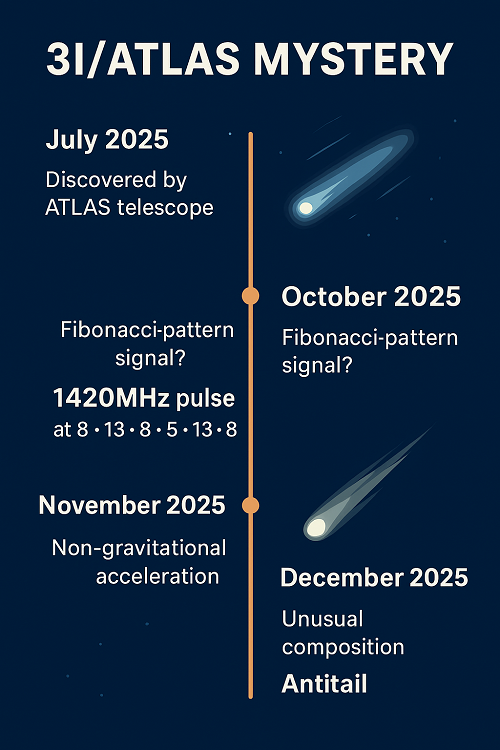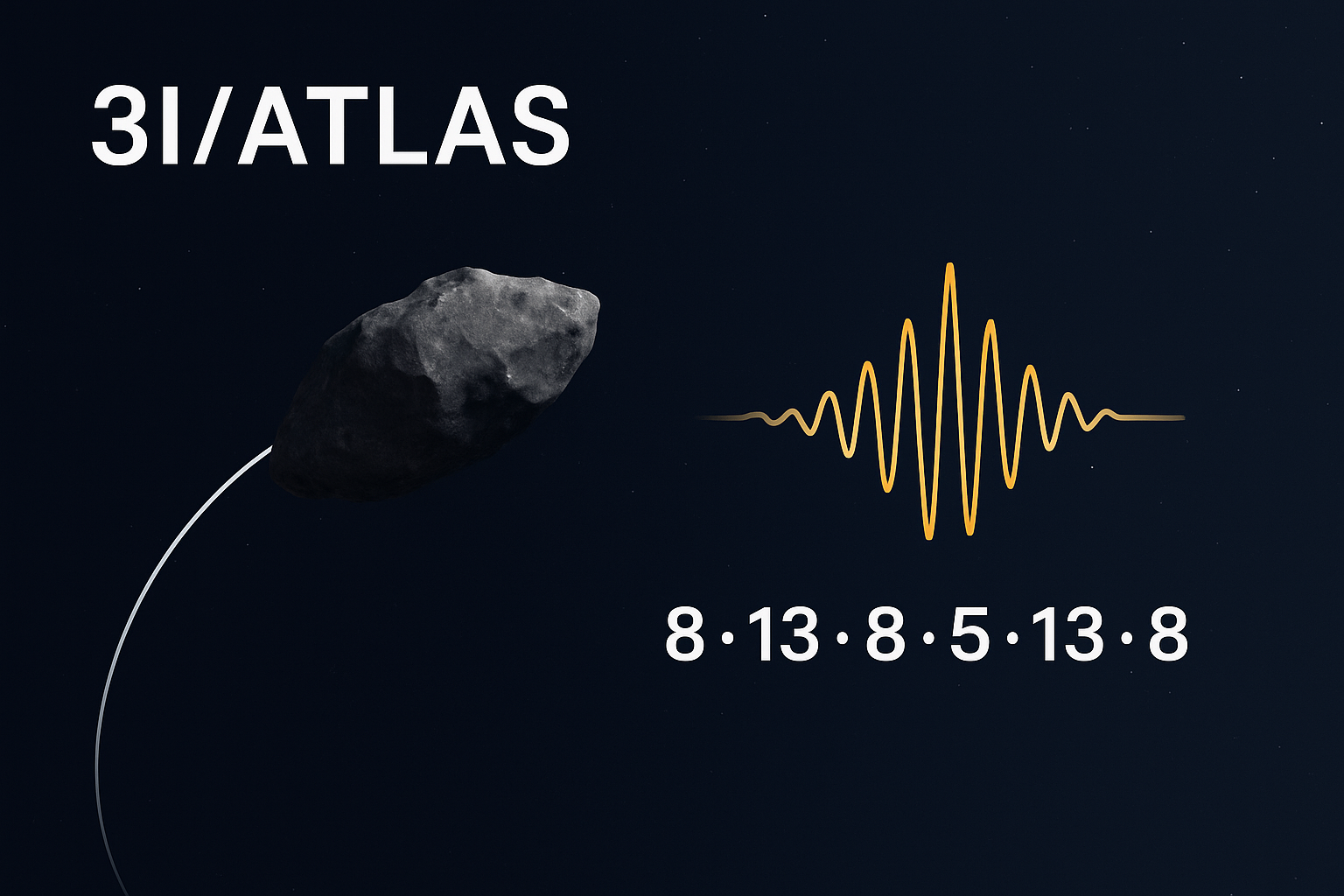Introduction
The cosmic visitor known as 3I/ATLAS has captured the imagination of scientists and the public alike, sparking the “3I/ATLAS mystery”. Between bold claims of mysterious pulse-signals resembling Fibonacci sequences, and debates about whether the object might be alien technology rather than a natural comet, the story is rich with intrigue. This article explores the 3I/ATLAS mystery: what’s been observed, what claims are being made, what scientists are saying, and what to watch next.

What is the 3I/ATLAS mystery?
The 3I/ATLAS mystery arises from the discovery of an interstellar object passing through our Solar System. Discovered in July 2025 by the Asteroid Terrestrial‑impact Last Alert System (ATLAS) telescope, it is only the third known interstellar visitor after 1I/ʻOumuamua (2017) and 2I/Borisov (2019).
But what has made it mysterious are several anomalous features: the possibility of a Fibonacci-pattern signal, non-gravitational acceleration, unusual composition, and a trajectory that many say defies expectations. All of this forms the heart of the 3I/ATLAS mystery.
The Fibonacci-pattern pulse: Key piece of the 3I/ATLAS mystery
One of the most sensational claims tied to the 3I/ATLAS mystery is that the object may be transmitting a pulse sequence at the 1420 MHz “hydrogen line” frequency — a frequency often used in SETI (Search for Extraterrestrial Intelligence) research. According to some viral posts, this sequence is 8 • 13 • 8 • 5 • 13 • 8, resembling a Fibonacci‐type pattern.
If true, that would add a puzzling chapter to the 3I/ATLAS mystery. The suggestion is that the pattern is intentional, possibly designed to signal intelligence, rather than an accident of nature. That said, scientists have not confirmed the pulse beyond social‐media claims, and caution widely remains.
The non-gravitational acceleration and trajectory: A deeper dimension of the 3I/ATLAS mystery
Beyond pulses, the 3I/ATLAS mystery deepens with claims of non-gravitational acceleration—behaviour meaning that the object’s motion cannot be explained purely by gravity and known comet jets. Physicist Avi Loeb and collaborators highlight data showing deviations from gravity‐only trajectories in Medium blog posts.
For example, Loeb notes that if the object were simply a comet shedding ice, the amount of mass lost to create the acceleration would be huge—so huge that it strains plausibility. He suggests the possibility the acceleration is a “technological signature” of internal propulsion.
This facet of the 3I/ATLAS mystery raises fundamental questions: Is this object purely natural or something engineered? If engineered, what is its purpose?
Composition, tail anomalies and other strange behaviours: More clues in the 3I/ATLAS mystery
Several other oddities feed into the 3I/ATLAS mystery. Among them:
The object reportedly emits nickel but little iron, which is unusual in typical comet outgassing.
It has displayed an “anti‐tail” (a tail pointing toward the Sun rather than away) in some observations.
The trajectory is highly hyperbolic (meaning it will not return to our Solar System) and possibly comes from an ancient region of the Milky Way.
All these feed into the broader 3I/ATLAS mystery: why does this interstellar visitor defy typical comet behaviour? What does it mean for our understanding of interstellar objects?
Science moderates the hype: The 3I/ATLAS mystery in perspective
While the 3I/ATLAS mystery is fascinating, scientists emphasise caution. The claim of a Fibonacci pulse signal remains unverified by peer-reviewed journals or major observatories. Some media outlets piece the claims together carefully, noting that the signals may be spurious or misinterpreted.
In his blog posts, Avi Loeb presents the possibility of artificial origin if non-gravitational acceleration persists without typical cometary outgassing explanations—but he does not insist it is alien tech, only that the data merits scrutiny.
Thus the 3I/ATLAS mystery remains open-ended: a compelling puzzle in progress rather than a solved case.
Why the 3I/ATLAS mystery matters
Why pay attention to the 3I/ATLAS mystery? Here are key reasons:
Scientific opportunity: As an interstellar visitor, 3I/ATLAS gives astronomers a chance to examine material and phenomena from beyond our Solar System, advancing knowledge of how planets, stars and interstellar objects form and behave.
SETI implications: If the pulse claims or other anomalous behaviours turn out to be artificially derived, this could shift how we search for extraterrestrial intelligence altogether.
Planetary defence and space science: Understanding interstellar objects helps refine models of celestial mechanics, object origins, and potential future visits.
Public engagement: The 3I/ATLAS mystery engages the public imagination and can inspire interest in astronomy and science.
What to watch next in the 3I/ATLAS mystery
If you’re following the 3I/ATLAS mystery, here are upcoming developments worth watching:
Observations of 3I/ATLAS as it moves away from the Sun and away from Earth: tracking changes in its brightness, tail, and composition.
Data from the International Asteroid Warning Network (IAWN) or other observatories that may detect or rule out mass loss consistent with typical comet jets. (As noted by Loeb, a large gas cloud absence would lean toward non‐natural origins)
Any confirmation of the pulse sequence (8 • 13 • 8 • 5 • 13 • 8 at 1420 MHz) from scientific observatories rather than social-media claims.
Peer-reviewed research papers documenting anomalies, trajectories, composition findings and non-gravitational effects.
Public statements or data releases from major agencies (e.g., NASA) clarifying their observations of 3I/ATLAS.
FAQ Section
Q1. What exactly is the “3I/ATLAS mystery”?
It refers to the set of puzzling observations tied to 3I/ATLAS — including alleged Fibonacci‐pattern pulses, unusual trajectory and acceleration, odd composition, and the debate whether it is a natural interstellar comet or something more engineered.
Q2. What is the significance of the fibonacci‐pattern pulses in the 3I/ATLAS mystery?
The pulses (claimed sequence 8 • 13 • 8 • 5 • 13 • 8 at 1420 MHz) are intriguing because the 1420 MHz hydrogen line is used in SETI research and the numeric pattern resembles the Fibonacci sequence—a mathematical pattern found in nature—and thus some suggest it could be a deliberate signal.
Q3. Has the fibonacci signal from 3I/ATLAS been verified by scientists?
As of now, no major scientific observatory or peer-reviewed study has confirmed the pulse claim. Much of the discussion remains in news and commentary rather than scientific consensus.
Q4. What is meant by ‘non-gravitational acceleration’ in the context of the 3I/ATLAS mystery?
It means that the object’s motion shows deviations from what would be expected by gravity alone, suggesting additional forces at work (e.g., outgassing in a comet) or possibly an internal mechanism. Some scientists point to this anomaly as a key facet of the 3I/ATLAS mystery.
Q5. Could 3I/ATLAS be alien technology?
Some scientists (notably Avi Loeb) consider the possibility given the anomalies, but the majority view in astronomy remains that natural explanations are likelier unless proven otherwise. The idea remains speculative, and thus part of the 3I/ATLAS mystery—not resolved.
Q6. Does 3I/ATLAS pose any danger to Earth?
No. According to current data, 3I/ATLAS will not come close enough to Earth to pose a risk. The 3I/ATLAS mystery is about understanding its nature, not fearing it as a threat.
Q7. How can amateur astronomers follow or observe the 3I/ATLAS mystery?
Given its distance and faintness, seeing 3I/ATLAS requires a good telescope and timing. But you can follow updates from observatories, NASA, and astronomy groups that will issue alerts about any interesting findings or campaigns relevant to the 3I/ATLAS mystery.
Conclusion
The 3I/ATLAS mystery encapsulates one of the most compelling space-science stories of 2025: an interstellar visitor with unusual behaviours, pulse signal claims, and questions of natural vs artificial origin. While much remains unverified and speculative, the object invites us to expand how we think about interstellar space, comets, and possibly even intelligence beyond Earth.
As more data rolls in from telescopes and observatories, the 3I/ATLAS mystery will evolve — perhaps resolving some questions, or raising many more. Either way, it’s a fascinating chapter in our cosmic journey.
+ Best Telecom Data Settlement Secrets : Don’t Miss Your Benefit AT&T $177M
+ iPhone 16 Pro Reduced Price : Major Festival Sale Slashes Flagship Costs
+ Motorola Edge 70 : The Ultra-Slim Smartphone That Redefines Flagship Design






